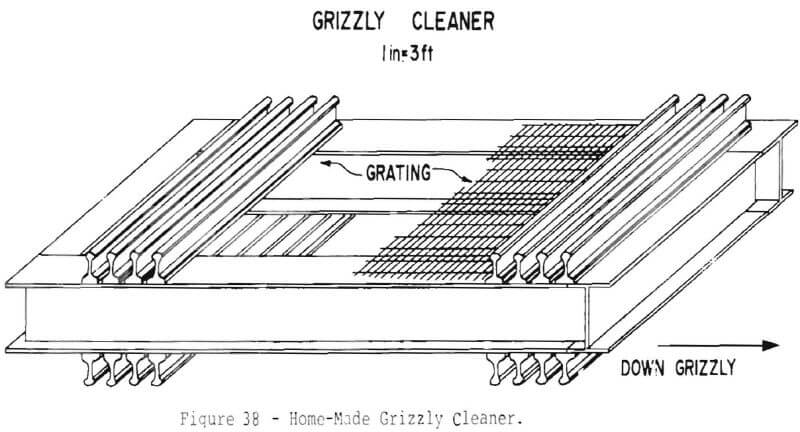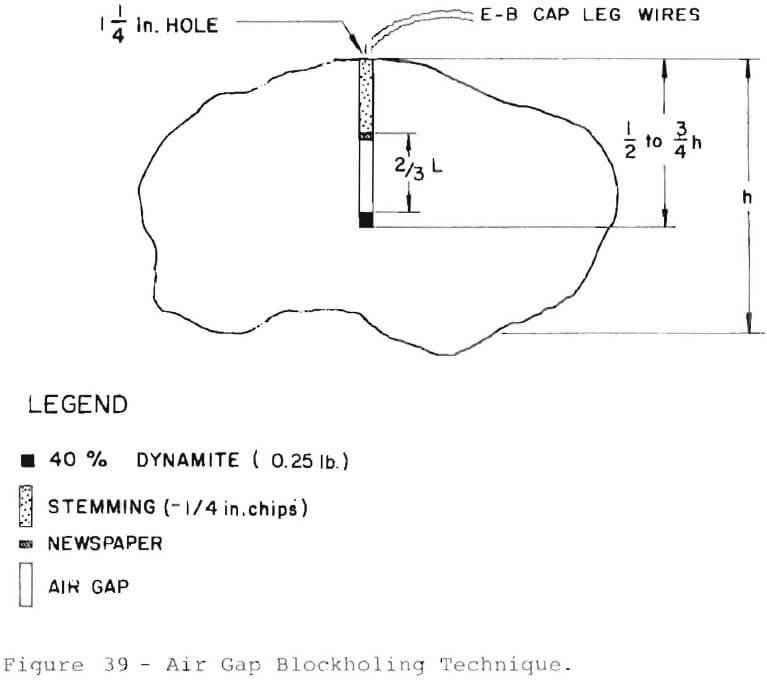Table of Contents
Several products have come on the market in recent years that improve the safety of secondary blasting operations. The most significant of these are binary explosives, exploding bridgewire electric blasting caps, and nonelectric systems.
Binary Explosives
Binary explosives are two nonexplosive materials that become cap sensitive, high energy explosives when mixed. One part can be fertilizer grade ammonium nitrate, and the other nitromethane. Oftentimes they are available in plastic tubes or flexible foil pouches that can easily conform to the boulder surface. These explosives can replace stick explosives for mudcapping although they are more expensive.
Since binary explosives are not classified as explosives until mixed, their storage and handling is greatly simplified and less costly. They are also less sensitive to shock than dynamite and do not cause powder headaches for the user. As mentioned, the extra cost of the product is a primary disadvantage. Care must be taken when inserting the cap in the charge to assure detonation. It is best to insert a blasting cap only about 0.5 in.
Several binary explosives are available as shown in Table 5. Their properties and costs are compared with conventional explosives.
Exploding Bridgewire Caps
One disadvantage of electric blasting caps is their susceptibility to stray currents. An exploding bridgewire (EBW) cap has been developed that can only initiate when supplied with a specific high voltage. This current heats a gold bridgewire to vaporization, a process that creates shock waves and thermal energy which is enough to detonate the base charge in the cap. Low voltage will not detonate the base charge because its lower density makes it less sensitive to impact.
Figure 12 shows an EBW cap in cross-section. The main difference from a conventional cap is in the material surrounding the bridgewire. This different construction permits the cap to fire only under certain circumstances. The firing system needed for these EBW caps consists of a control unit and a firing module. This specialized system is more expensive than blasting machines for conventional caps.
The control unit provides low voltage of about 40 volts of electrical energy to the firing module. For added safety, a hold-to-arm and a hold-to-fire button are supplied so that the shot firer can abort the firing by releasing either button. Batteries can fire 100 shots before requiring recharging by a 115 volt AC power source.
The firing module converts the input voltage from the control unit to 3,000 volts. The module must be placed relatively close to the cap (about 100 ft maximum) so as to assure minimum voltage loss and vaporization of the bridge-wire.
One large metal mining company in Canada exclusively uses EBW caps for secondary blasting. The cap, because of its low sensitivity and specific detonation requirements, is allowed to be transported and stored as a blasting agent or nonexplosive, thus reducing storage problems. When needed, an explosive charge such as a two component binary explosive (which also is nonexplosive) is placed and the EBW inserted and fired by the special device required. Thus, all three components, the EBW cap and the two binary components, may be readily and safely stored and used with considerable safety.
However, the present cost of a single EBW cap is $5 and there is only one manufacturer. Firing units are also expensive, but no magazines or other such precautions are necessary, thus the storage advantage may offset the cost.
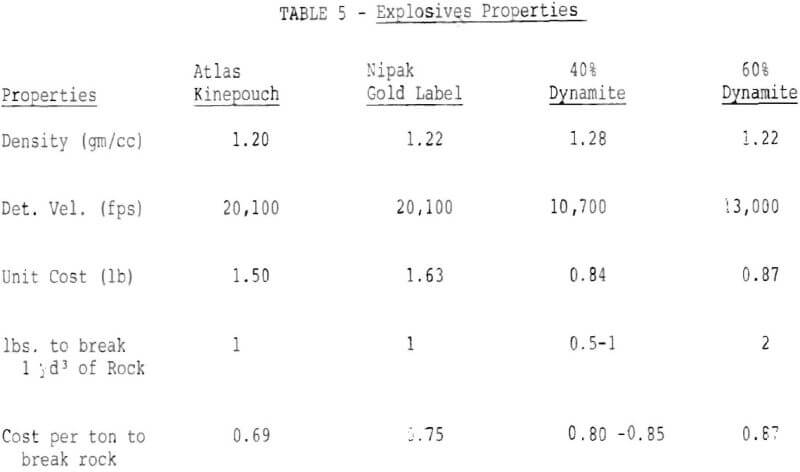
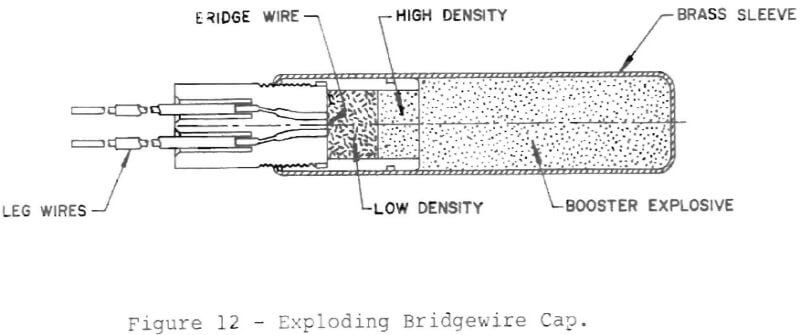
Nonelectric Systems
There are two types of nonelectric initiating systems which cannot be affected by stray electric current and are compatible with commercial explosives. One system utilizes a small diameter flexible tube that is lined with a small amount of explosive that propogates when initiated and fires the main explosive charge.
Another type of system uses a fuel/oxidizer gaseous mixture that is introduced through a network of tubing and then ignited by a special blasting machine.
Although special equipment is needed, both systems were developed for primary blasting and therefore the systems are adaptable to a variety of requirements. The systems are quite portable and only require special caps, blasting machine, and tubing which can be pre-cut to required length.
Ongoing research in demolition may one day be applied to safe, economical boulder breaking. Presently the methodology is cost prohibitive or not developed to its full potential and therefore limited to small scale use. A literature search in this area defined two basic categories of future applicable technology: explosive and non-explosive, where the latter is the larger group. A number of systems are presented here but only as food for thought.
Explosives Methods
Energetic Explosives
The term energetic explosives refers to a high brisance, high velocity explosive. Brisance describes the ability of an explosive to shatter and fragment steel, concrete, and other very hard materials. A good example of a commercially used energetic explosive is the cast primer used to initiate blasting agents. Some of these high brisance explosives are TNT (trinitrotoluene), PETN (pentaerythritol nitrate), RDX (cyclotrimethylene trinitramine or cyclonite), and tetryl.
Energetic explosives can be used in smaller amounts to replace dynamite in “bombs” for unconfined boulder blasting where no specific or special order of explosives would be needed, or in mudcapping to decrease the amount of explosives used.
Ribbon Explosives (Military)
Ribbon explosives, sometimes called Flex-X, (Figure 27) is a military explosive. It is made from 63% PETN, 8% nitro-cellulose, and 29% elastomeric binder. The M186 roll demolition charge, as the military identifies it, is 3 in wide, ¼ in thick, and 50 ft long so it can be cut to any length. This ribbon explosive is backed with pressure sensitive tape and can be shaped and contoured to most any object. The ribbon could also be shaped around suspected weakness zones in a boulder and distribute the explosive power to that weakness zone. Ribbon explosives are designed for cutting through steel but they lack the mass concentration necessary to break boulders provided they are just laid on top of the rock. For the ribbon explosive to have a shattering effect, the length over thickness ratio must be greater than 2.5. This ratio will permit the explosive to reach steady state velocity, however, the diameter of the explosive will probably be too small to deliver a damaging blow to the rock.
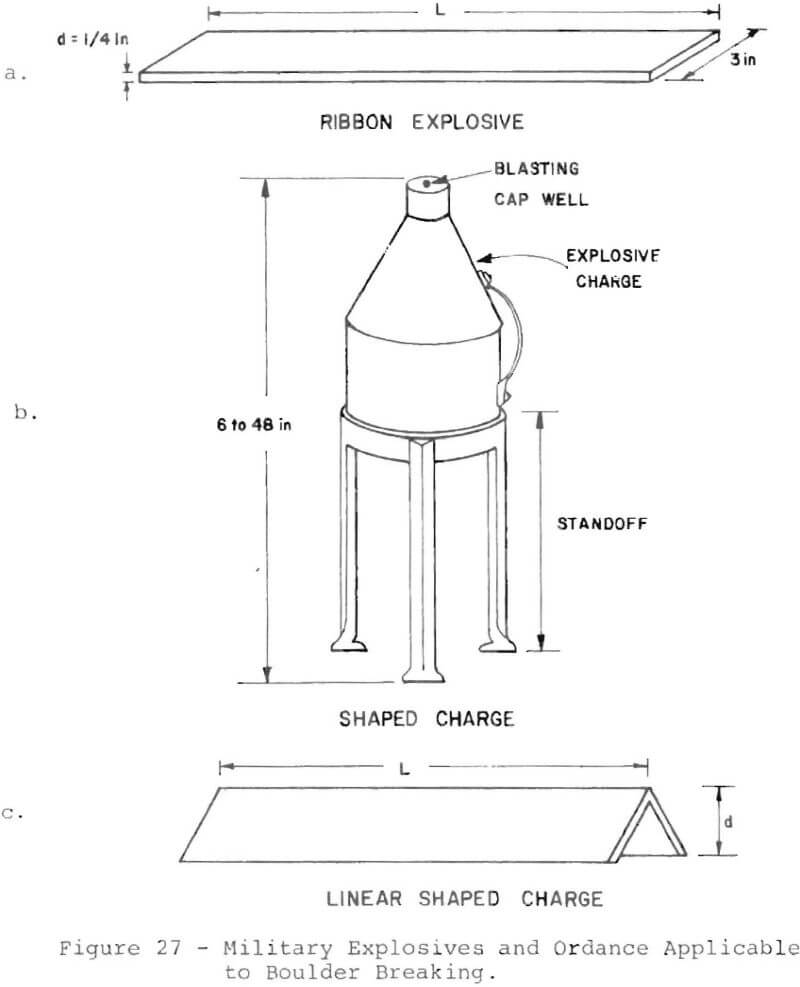
Shaped Charges
A shaped charge is an explosive contained in a case so shaped as to concentrate the power of the explosion in one small area (Bureau of Mines, 1980). A shaped charge looks like an inverted cone with legs (see Figure 27).
Shaped charges are very effective for cutting holes through reinforced concrete thereby making shaped charges extremely useful in military operations and may have some application to boulder blasting but use in crushers is questionable. The biggest disadvantage of shaped charges are the flyrock potential and the high noise level.
Linear Shaped Charge
A linear shaped charge is a combination of ribbon explosives and a shaped charge. A linear shaped charge is similar in appearance to angle iron (Figure 27).
A linear shaped charge is similar to a shaped charge in that the concentration of the force of the explosive is along the line of the explosive; however, a linear shaped charge does not have the concentrated mass necessary, due to the large length to thickness ratio, to create a shattering effect. Consequently the explosive force would tend not to penetrate the rock. Another disadvantage of linear shaped charges is that a worker must go into the crusher area to place the explosive thus increasing the accident potential.
Contained Projectile
A contained projectile is an unconfined shaped charge with a projectile in contact with the bottom of the explosive (Figure 28). The projectile and explosive would stand a few inches above the boulder with the aid of legs supporting the unit. At the time of initiation a shaped charge concentrates the explosive force onto the boulder at a very high velocity creating a shock wave that breaks the boulder.
This method of boulder blasting has potential because it is a fast method and allows placement of explosives without being in the crusher mouth area. The addition of a projectile amplifies the cutting force of the shaped charge into a shattering force necessary to break boulders, however the potential for crusher damage is high.
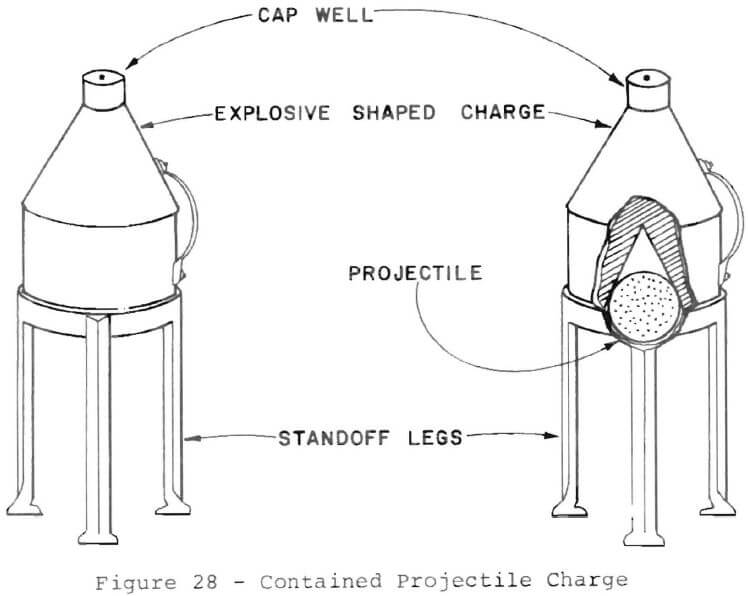
Non-explosive Methods
Electron Beam
An electron beam is a device which utilizes a dense stream of high-velocity electrons to impact and melt rock. The electron beams are produced from high voltages (30 to 200 kv) which accelerates the electrons traveling between two electrodes. The electrons are focused by a magnetic lens located close to one of the electrodes. Aligning coils are used for fine focusing of the beam (Maurer, 1979), Figure 29.
The electron beam has potential for being a boulder breaker, however, the x-rays given off make the electron beam a health hazard. Very little work has been done to test the potential of the electron beam as a boulder breaking method.
Spark
The spark method of breaking rock utilizes high-voltage capacitors discharging across two or more electrodes Figure 30, to produce shock waves which crater the rock (Maurer, 1979). Even though the spark creates a high enough temperature to melt the rock, it cannot, because the spark is of such short duration, usually 1 to 50 microseconds.
The spark method of rock breaking has great potential in deep hole drilling, but as yet to be tested for boulder breaking.
Flame Jet
A flame jet is a rock cutting method which uses a high-velocity flame powered by air or oxygen enriched air oxidized with fuel oil, as shown in Figure 31 (Maurer, 1979). The heat from the jet flame weakens the rock structures while the high velocity aids cutting through the rock. Abrasives such as sand can be added to the jet to increase the density and cutting ability.
A flame jet in 15 minutes, can cut a kerf 1¾ ft deep x 4 in wide x 2½ ft long in Barre Granite. This rate can be greatly increased with the use of abrasives. The flame jet can be used to cut enough rock off the boulder so as to fall into the crusher mouth.
The advantages of using a flame jet for boulder breaking is the elimination of both dangerous flyrock and the need for personnel to be in the crusher area. The
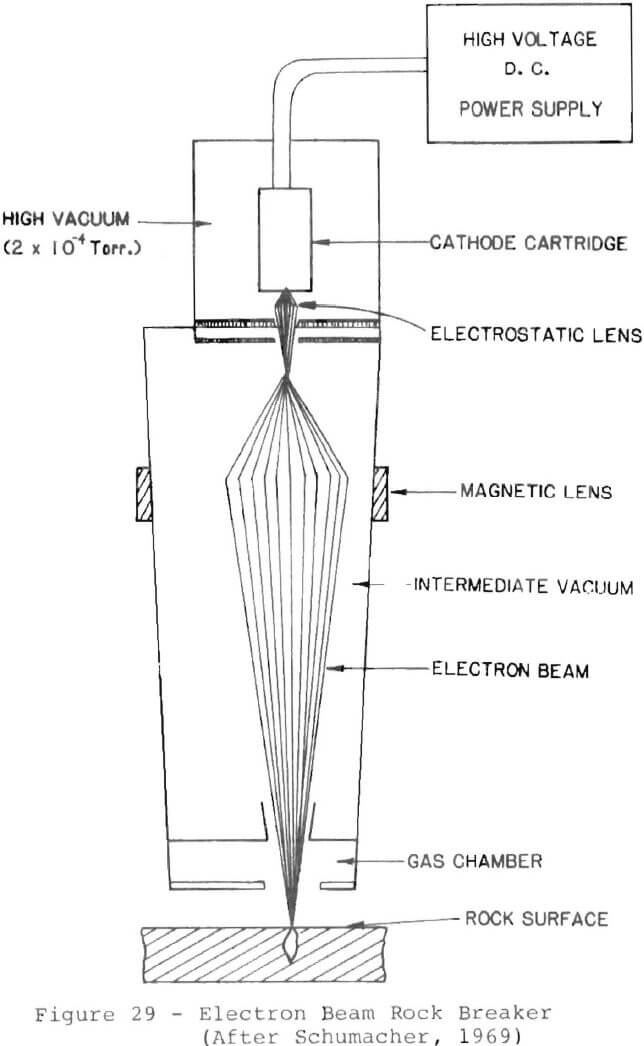
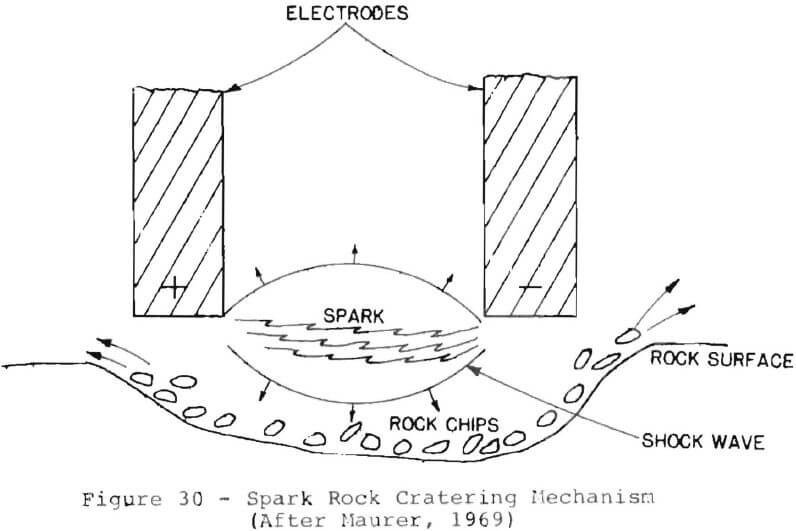
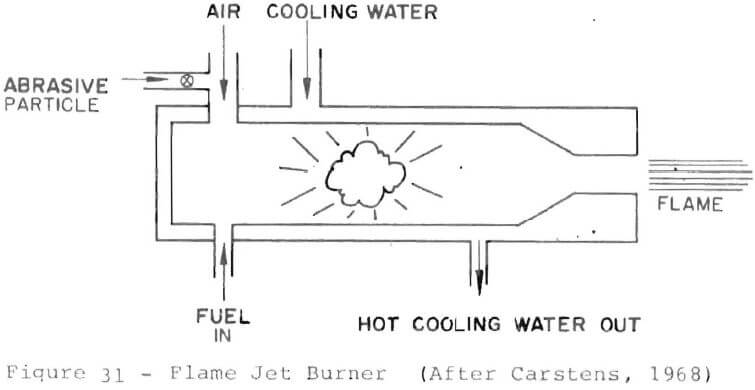
disadvantages include the dangers of combustible material and noise from the jet. The flame jet has some potential as a boulder breaking method but needs further testing.
Burning Bar
The burning bar method for boulder breaking burns or melts the boulder into smaller pieces. The Nordberg crusher manufacturer recommends this method for many of their crushers. A burning bar is a butane or propane fueled stick-shaped burner. When a boulder needs to be broken the burn bar is placed at the desired location and allowed to burn through the rock.
This method will not harm crusher parts but it is slow in reducing boulder size.
REAM Projectile
The REAM projectile method of rock breakage uses concrete projectiles fired from a cannon (Maurer, 1979). The system has been developed as the REAM tunneling system (Rapid Excavation And Mining) where 8.5 to 10 lb concrete projectiles are fired with velocities up to 64 ft per second at the rock to be broken.
Sixty-two tests have been tried with this technique as a secondary breakage method. Boulders ranging in size from 2 tons to 45 tons were used. The projectile kinetic energy required for breakage ranges from 55,320 ft-lb for a 1 ton boulder to 2,950,400 ft-lb for the 10 ton boulders. The standoff distance, or the distance from the cannon to the boulder, ranged from 50 to 200 ft. Figure 32 shows a REAM cannon mounted near a crusher in an idealized working position. Caution is deeded in the use of REAM projectiles for secondary breakage because excessive impact energy will result in flyrock. There is also a danger to the crusher if the projectile misses its mark and hits the crusher.
Electrical Disintegration
An electrical technique for fragmenting rock, called Electric Disintegration, has been developed (Maurer, 1979).
Electric disintegration passes an electric current through the rock to heat and thermally fracture the rock. The thermal stresses produced in the rock are the result of:
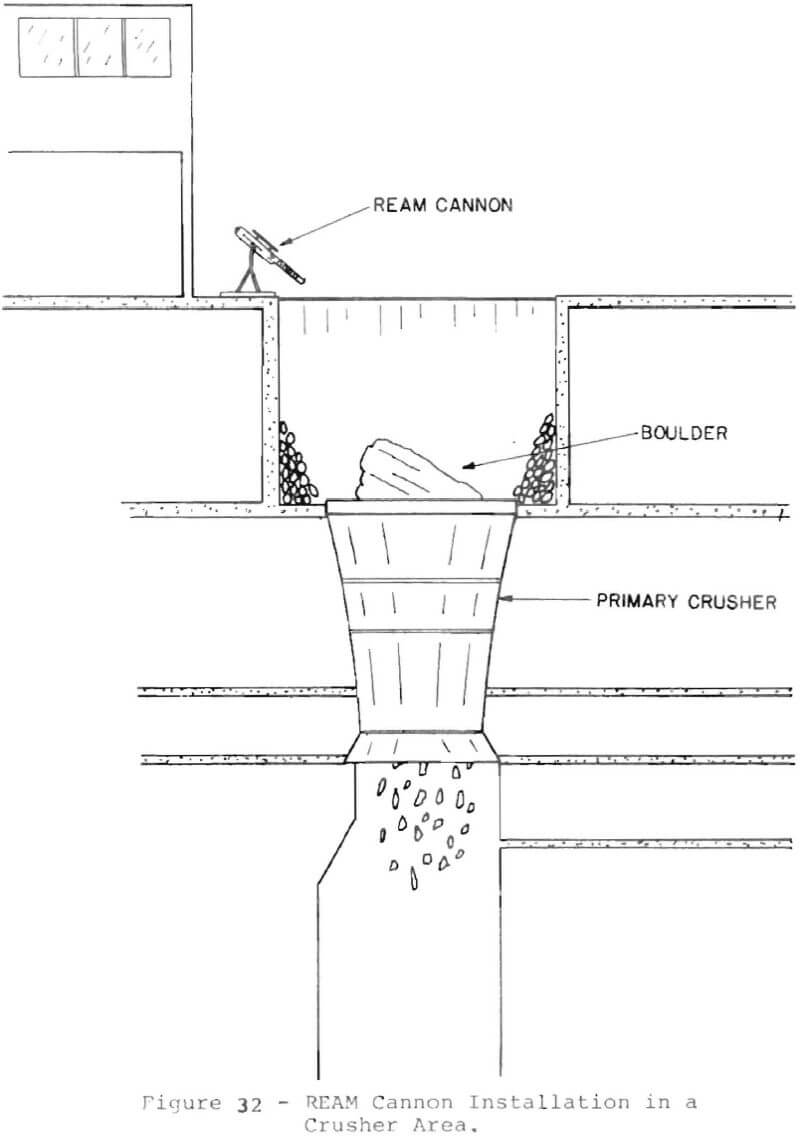
- differential thermal expansion of constituent minerals
- chemical decomposition of rock components
- expansion of gas and moisture
- phase transition of minerals
Electric disintegration has good potential for boulder breakage. In tests, four ton blocks of ore were shattered after only 2 to 3 minutes exposure to the electrical current (James and Hertel, 1967).
Peak power outputs of 445 kw were used during the test with electrode potentials of 100 to 600 volts. The electric disintegration method of breakage can be used both on the surface or underground by attaching the mechanism to a pivotal boom as in Figure 33. This method is both fast and easy; however the initial cost is high and without trained personnel the electrical hazard could be very dangerous.
Water and Air Jets
Water and air jets are high pressure, high velocity narrow sprays, which are able to produce a high strength cutting force. These sprays exit the nozzles, figure 34, at pressures up to 1,000,000 psi with a velocity up to 12,000 ft per second.
The jet spray can be continuous or pulsating. A single pulse from pulsating water jet can penetrate a 5 in thick piece of copper or a 1¼ in thick piece of steel. Water jets tend to be more effective than air because of the higher density of water compared to air. The impact force of a water jet can be improved by adding solid particles to the water, thus increasing the density which increases the impact force of the jet spray.
For boulder reduction in the crusher, water jets would be used to cut the boulder instead of breaking it with a shattering force. There could be a noise problem with the uses of water jets due to the noise developed from high speed motion; however, further testing of boulder breaking by water jets will be needed.
Breakage by Expansion
A chemical method of breaking rock by expansion exists but is not very practical for breaking boulders in crushers to date. The product is Bristar, manufactured by the Onoda Cement Company, Ltd. of Japan. This product is a non-explosive demolition agent made from a special silicate and organic compound that need only be mixed with water.
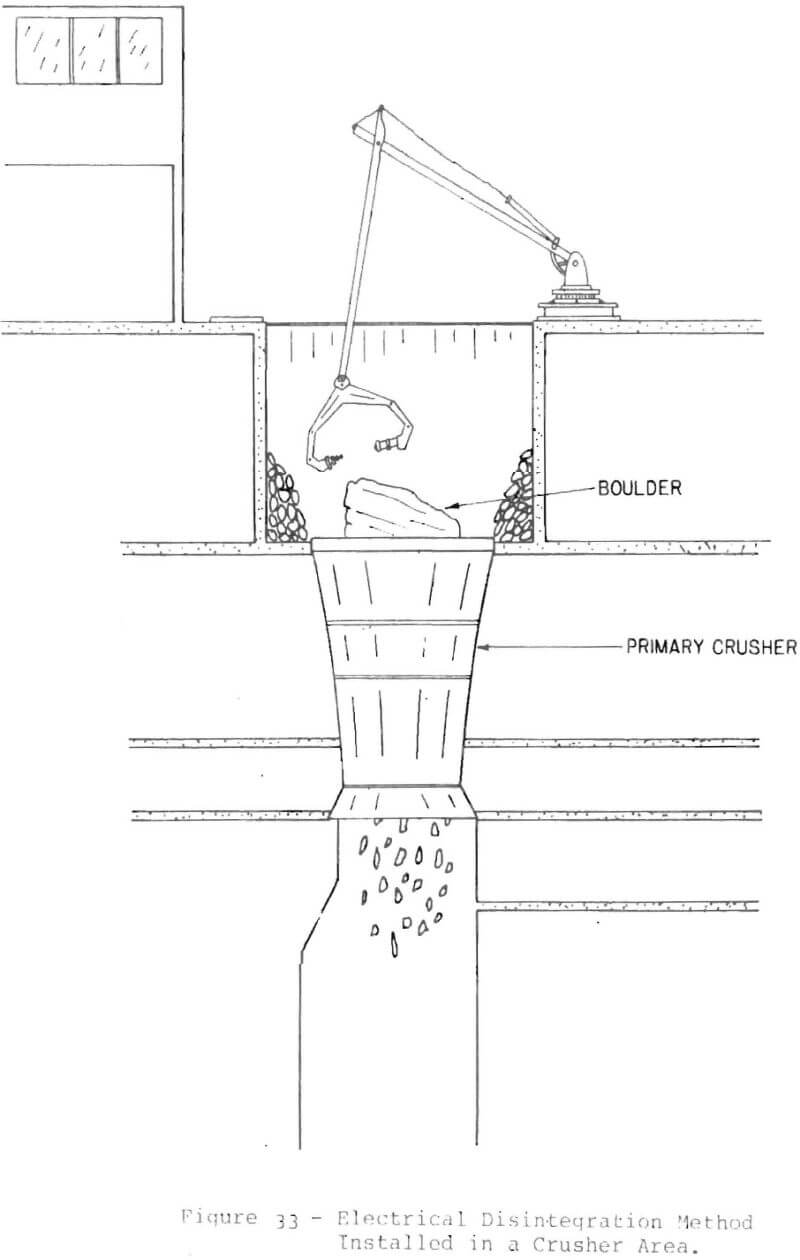
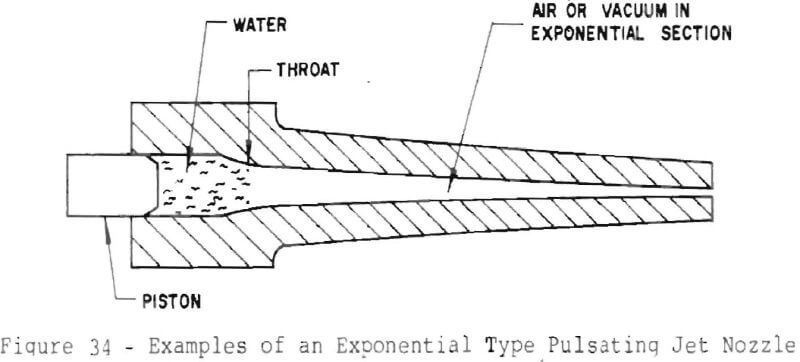
To use the product, first a hole of 36 to 52 mm must be drilled to 2/3 the depth of the boulder. The amount of Bristar needed is mixed with water in parts of 5 kg Bristar with 1.5 l, of water. This slurry must then be poured into the hole within 15 minutes, and it must completely fill the hole. One 5 kg bag is enough to fill eight feet (2.4 m) of 1½ inch (38 mm) hole. In time, expansion stresses of 3,000 t/m² build up to promote crack initiation, crack propagation, and an increase in crack width. Within 10 to 20 hours, cracks develop having widths of 10 to 30 mm (0.4 to 1.2 in.) making the rock easily picked apart. Performance is based primarily on hole depth.
Advantages of this method are similar to other non-explosive techniques. No licensing is required and no flyrock, dust, or noise will exist. The procedure requires very little training, and unlike other expansion techniques, there is no danger of having to plug the hole top and have the plug fly loose from pressure buildup of the chemical reaction as for example quicklime and water.
Disadvantages include very long action time, the necessity of drilling a hole, and the great dependence of performance on rock temperature. Colder temperatures lengthen the cracking time.
This particular method is mentioned not for its applicability of breaking boulders in crushers, but because it may evolve into a very practical method in the future; particularly if performance times can be reduced from twelve hours to twelve minutes. Present applications cat. replace secondary blasting of boulders in a quarry pit.
Recommendations for Safer Practices
Of course the simplest and most effective remedy to the problem is to never deliver an oversized boulder to the crusher. This requires care in primary blasting, and knowledgeable loader operators.
Improved Accessibility
From accident data investigations and field visits it is apparent that poor access to boulder blockages is a major contributor to injuries. Figures 35 and 36 show access to two different gyratory crushers. The access in Figure 35 utilizes a steep ladder leading to an unconsolidated rockpile. The workman could easily slip on the ladder or while walking on the loose rockpile to the crusher. Figure 36 also uses an access ladder to the crusher, but a hand rope is added near the bottom ladder section suggesting that the travel is difficult. The platform or catwalk above the crusher is covered with material that can contribute to injury. To aid in the safety of this area, a safety line must be required for any traveling to descending levels by ladder. Also, no attempt should be made to travel unless at least two persons are available; one to venture to the crusher mouth, and one to aid his travel, or be available for rescue. A cage surrounding a ladder, as recommended by OSHA would also improve safety as well as a platform to step on to rather than a rockpile.
To prevent accidental dumping of rock in the crusher when personnel are present, warning systems are necessary. A lighting arrangement works well, and an example is shown in Figure 37. A green light could mean dumping is allowed; and red lights will prohibit dumping.
Formal Adopted Procedure
Whatever arrangement is made for dealing with boulders, the plan should be well outlined and all personnel made aware of the plan. Good communications and procedures can prevent machinery starting when workers are in the crushers, accidental dumping of rock, people walking in on blasting, and so on. If an adopted procedure requires that workers enter the crusher area, then a procedure to carry out the work should be defined. The plan should include the responsibilities of all mine personnel in the area, and should be approved by the mine engineer, supervisors, and mine management. The plan should include all procedures and responsibilities of personnel from the time a boulder is hung up, to the time the crusher is cleared.
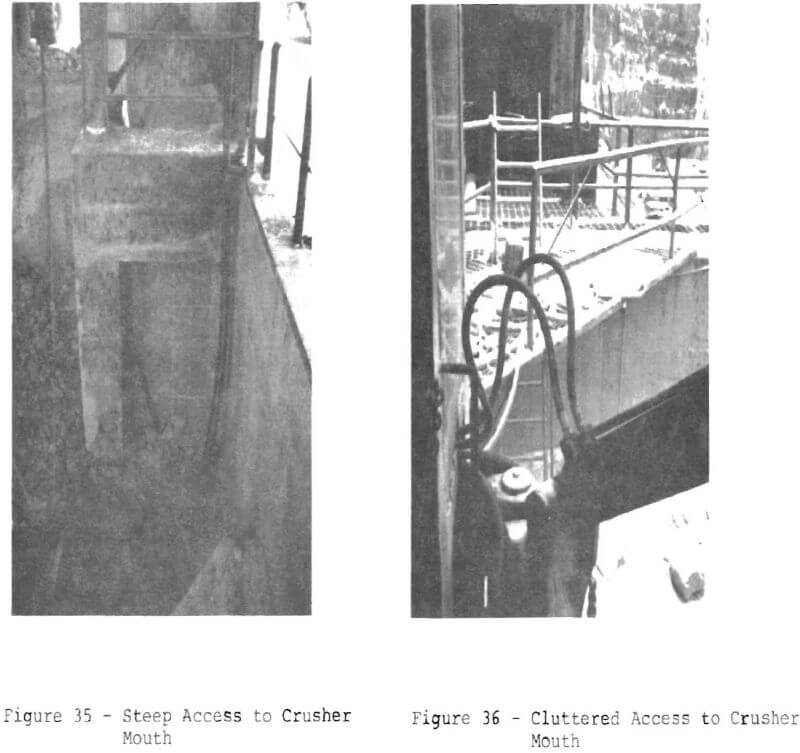
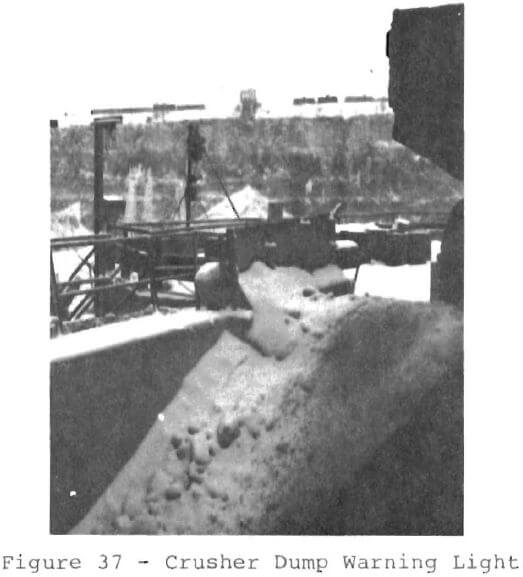
Improved Blasting Methods
Because of crusher damage, insufficiently trained persons, and general blasting hazards, blasting of boulders in crushers and grizzlies is to be discouraged. However, there may be situations where it is justifiable. In these cases the following is recommended:
- Persons should not enter upon or in a crusher unless for scheduled maintenance. Explosive charges should be placed by means of a pole or stick and subsequently mud covered in a similar fashion.
- Blockholing would be very difficult under these guidelines and should, therefore, be discouraged.
- Because of the inherently unstable situation of a bridging or hanging rock, insensitive products should be used so that a falling or shifting rock would not cause a detonation. Safety fuse caps, electric or nonelectric caps, and detonating cord may all detonate under impact and in turn detonate the explosive. Two component explosives and exploding bridgewire caps will minimize this problem as well as minimize magazine problems.
- Personnel handling explosives should be well trained in their use, and use only proper explosive devices for their initiation.
- When vibrating grizzlies are used to feed a crusher, every effort should be made to blast the boulder while on the grizzly rather than after it has entered the crusher mouth.
- A standard operating procedure should be adopted and cover the following operations as the minimum:
- Turn on “No Dumping” light to warn haul units that work is being done in the crusher area.
- Stop and lock out crusher, feeder, and conveyors so that the equipment cannot be started when
personnel are in the crusher mouth. - Examine the boulder blockage; use safety harness if necessary to prevent serious falls when traveling between levels.
- Notify certified blasting personnel to design the blasting approach thereby eliminating the condition in the safest manner.
- Obtain the blasting cables, machine, etc. and place the charge where desired.
- Take a head count of personnel in the area and sound a blast warning signal to assure no personnel stray into the blast area.
- Test the electrical connections to assure continuity and initiate the charge with approved equipment.
- Examine the blast results to see if the boulder was sufficiently broken, and that there are no undetonated explosives, or misfires.
- Sound the “All Clear” signal so that personnel can prepare to resume duties.
- Start electrical equipment and turn off the “No Dumping” lights.
- Blasting plan should be developed by a knowledgeable person, reviewed by the crusher manufacturer, reviewed by MSHA and state authorities, taught to personnel, and posted in a conspicuous place.
By following these simple guidelines, along with a definite plan with clearly defined responsibilities and procedures, blasting can be done in crushers if done very carefully with considerable forethought.
Other Considerations
The hazard analysis has placed explosive methods, manual methods, and mechanical methods in perspective in regard to safety. Economic judgements must of course be weighed by individual operators. However, boulder hang-ups can be reduced by:
- Better primary blast design to reduce boulders
- Loader operator training and experience to prevent loading of boulders
If blasting is the chosen method for handling boulders in crushers, a number of things can be done to reduce accident potential. Normal safe practices are necessary when storing and handling explosives and only experience, certified personnel should be allowed in the boulder blasting area. The incorporation of blast shelters as required in several state regulations could reduce injuries from flyrock and permit a head count of all people prior to blast initiation. A signal plan should be incorporated in to the procedure so as to warn all personnel who may come into the area. Safety blasting procedures such as these are common in any type of blasting. However, materials that are particularly applicable to boulder blasting exist and can further aid in accident prevention.
Boulder blasting in crushers implies that the surrounding area contains many electric lines leading to many types of equipment. This condition suggests that stray currents can be present and therefore pose a threat to premature detonation if electric initiation systems are used. Exploding bridgewire caps, as discussed earlier, successfully combat stray current initiation. Although more expensive, EBW caps provide a great safety advantage in transportation, storage, and use. The infrequent use of boulder blasting can also detract from the high EBW cost disadvantage.
Further safety can be obtained in congested areas of crushers by using a nonelectric system as discussed in Section 5.2.3. These systems are slowly gaining in popularity throughout the mining industry. Nevertheless all explosive work should be done by certified personnel, and with approved apparatus including lead wire and blasting machine. Previous discussion alluded to inclined grizzlies leading to the crusher mouth, and these grizzlies had to first be cleared of debris wedged between the bars before personnel could enter the crusher area.
One operator utilized a home-made grizzly cleaner that sped the cleaning process. The cleaner, illustrated in Figure 38 is moved by an overhead crane. Basically the cleaner is made from wide flange beams forming a frame, and railroad rail is laid across both sides so that either side can be used to clean. Grating is placed on one side so that occasionally the device can substitute for a work platform. The cleaner is slid down the grizzly and the railroad rail forces rock through the grizzly bars, or dislodges them so they can tumble to the crusher. Obviously the cleaner can save many man-hours of prying rock loose and can also improve safety by eliminating the need for workers to enter the area for cleaning grizzlies and steep incline.
Recommendations for Further Research
Home-Made Devices
A universal complaint of small mine operators is that they lack enough capital to obtain time saving and safer devices. Most equipment dealing with boulders does require power sources, booms, or elaborate overhead cranes.
It would be beneficial to explore inexpensive home-made devices that can alleviate boulder hangups.
Explosive Use Research
The project included an economic and hazard analysis of common boulder blasting techniques such as mudcapping and blockholing. Another technique which may have promise is air gap blockholing as shown in Figure 39. This allows less explosive to be used compared with blockholing, but the air gap provides a cushioning affect which greatly reduces the violence of the blast.
Blasting boulders in crushers is much different than blasting in a quarry pit and therefore powder quantities and placement for effective use may not apply because of excessive explosive force that could result. The actual explosive forces delivered to a crusher under a variety of situations should be investigated. It would be beneficial to determine, under controlled conditions, the minimum amount of explosive per cubic yard of boulder.
Economic Study
Most operators do not know how often or how long it takes then, to eliminate a boulder problem with their chosen method. A comprehensive time study of the many methods presented here can better help to determine, in an economic sense, the practical value of one boulder handling technique over another. It does appear from results obtained that if sufficient data were collected and then distributed to industry, blasting would become an extremely rare occurence.
